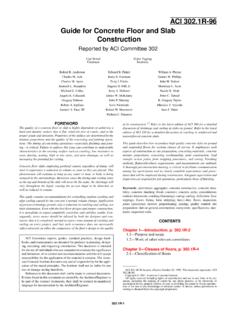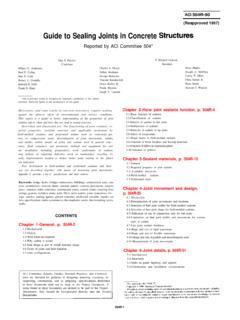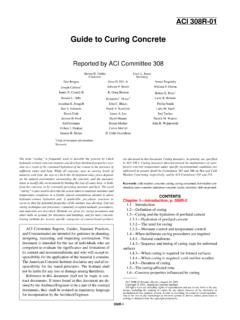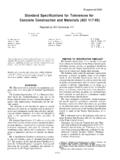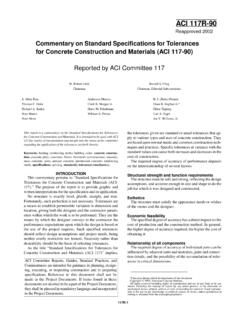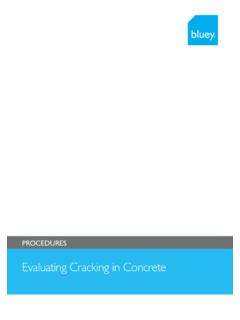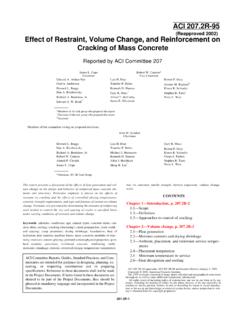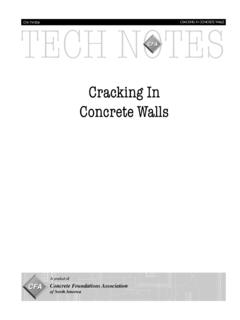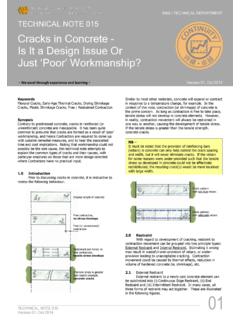Transcription of 224R-01 Control of Cracking in Concrete Structures
1 ACI 224R-01 supersedes ACI 224R-90 and became effective May 16, 2001, American Concrete rights reserved including rights of reproduction and use in any form or by anymeans, including the making of copies by any photo process, or by electronic ormechanical device, printed, written, or oral, or recording for sound or visual reproduc-tion or for use in any knowledge or retrieval system or device, unless permission inwriting is obtained from the copyright proprietors. ACI Committee Reports, Guides, Standard Practices,and Commentaries are intended for guidance in planning,designing, executing, and inspecting construction. Thisdocument is intended for the use of individuals who arecompetent to evaluate the significance and limitations ofits content and recommendations and who will accept re-sponsibility for the application of the material it American Concrete Institute disclaims any and all re-sponsibility for the stated principles.
2 The Institute shallnot be liable for any loss or damage arising to this document shall not be made in con-tract documents. If items found in this document are de-sired by the Architect/Engineer to be a part of the contractdocuments, they shall be restated in mandatory languagefor incorporation by the Architect/Engineer. 224R-1 Control of Cracking in Concrete StructuresACI 224R-01 The principal causes of Cracking and recommended crack- Control proce-dures are presented. The current state of knowledge in microcracking andfracture of Concrete is reviewed. The Control of Cracking due to dryingshrinkage and crack Control in flexural members, overlays, and mass con-crete construction are covered in detail. Long-term effects on Cracking areconsidered and crack- Control procedures used in construction are pre-sented.
3 Information is presented to assist in the development of practicaland effective crack- Control programs for Concrete Structures . Extensive ref-erences are : aggregates; anchorage (structural); bridge decks; cement-aggregate reactions; Concrete construction; Concrete pavements; concreteslabs; cooling; corrosion; crack propagation; Cracking (fracturing); crackwidth and spacing; drying shrinkage; shrinkage-compensating Concrete ;heat of hydration; mass Concrete ; microcracking; polymer-modified Concrete ;prestressed Concrete ; reinforced Concrete ; restraint; shrinkage; temperature;tensile stresses; thermal expansion; volume 1 Introduction, p. 224R-2 Chapter 2 Crack mechanisms in Concrete , p.
4 Compressive FractureChapter 3 Control of Cracking due to drying shrinkage, p. Cause of Cracking due to drying Drying Factors controlling drying shrinkage of Control of shrinkage Shrinkage-compensating concreteChapter 4 Control of Cracking in flexural members, p. Crack- Control equations for reinforced Concrete Crack Control in two-way slabs and Tolerable crack widths versus exposure conditions inreinforced Flexural Cracking in prestressed Anchorage-zone Cracking in prestressed Crack Control in deep Tension crackingReported by ACI Committee 224 Mohamed Abou-ZeidDavid W. Fowler*Edward G. Nawy*John H. AllenGrant T. HalvorsenRandall W. Poston*James P. BarlowWill Hansen*Royce J. RhoadsMerle E. Brander*M.
5 Nadim HassounAndrew ScanlonKathy CarlsonHarvey Haynes*Ernest K. Schrader*David Darwin*Paul HedliWimal Suaris*Fouad H. Fouad*Tony C. LiuZenon A. ZielinskiFlorian BarthChairmanRobert J. Frosch*Secretary*Members of ACI 224 who assisted in revisions to this COMMITTEE REPORTC hapter 5 Long-term effects on Cracking , p. Effects of long-term Environmental Aggregate and other Use of polymers in improving Cracking characteristicsChapter 6 Control of Cracking in overlays,p. Fiber-reinforced Concrete (FRC) Latex- and epoxy-modified Concrete Polymer-impregnated Concrete (PIC) Epoxy and other polymer Concrete overlaysChapter 7 Control of Cracking in mass Concrete , p. Methods of crack OperationChapter 8 Control of Cracking by proper construction practices, p.
6 Specifications to minimize drying ConclusionChapter 9 References, p. Referenced standards and Cited Other referencesCHAPTER 1 INTRODUCTIONC racks in Concrete Structures can indicate major structuralproblems and detract from the appearance of monolithicconstruction. There are many specific causes of report presents the principal causes of Cracking and adetailed discussion of crack- Control procedures. The reportconsists of eight chapters designed to help the engineer andthe contractor in developing crack- Control report is an update of previous committee reports(ACI Committee 224 1972, 1980, 1990). ACI Bibliogra-phy No. 9 supplemented the original ACI 224R (1971). TheCommittee has also prepared reports on the causes, evaluation,and repair of Cracking , ACI ; Cracking of Concrete in di-rect tension, ACI ; and joints in Concrete construction,ACI this revision of the report, Chapter 2 on crack mechanismshas been revised extensively to reflect the interest and attentiongiven to aspects of fracture mechanics of Concrete during the1980s.
7 Chapter 3 on drying shrinkage has been 4 has been revised to include updated informationon crack-width predictive equations, Cracking in partiallyprestressed members, anchorage zone Cracking , and flexuralcracking in deep flexural members. Chapter 6 on concreteoverlays has been reorganized and revised in modest detailto account for updated information on fiber reinforcementand on polymer-modified Concrete . Chapter 7 on massconcrete has been revised to consider structural consequencesmore extensively. CHAPTER 2 CRACK MECHANISMS IN IntroductionCracking plays an important role in Concrete s response toload in both tension and compression. The earliest studies ofthe microscopic behavior of Concrete involved the responseof Concrete to compressive stress.
8 That early work showedthat the stress-strain response of Concrete is closely associatedwith the formation of microcracks, that is, cracks that form atcoarse-aggregate boundaries (bond cracks) and propagatethrough the surrounding mortar (mortar cracks) (Hsu, Slate,Sturman, and Winter 1963; Shah and Winter 1966; Slate andMatheus 1967; Shah and Chandra 1970; Shah and Slate1968; Meyers, Slate, and Winter 1969; Darwin and Slate1970), as shown in Fig. early microcracking studies, Concrete was consideredto be made up of two linear, elastic brittle materials; cementpaste and aggregate; and microcracks were considered to bethe major cause of Concrete s nonlinear stress-strain behaviorin compression (Hsu, Slate, Sturman, and Winter 1963; Shahand Winter 1966).
9 This picture began to change in the1970s. Cement paste is a nonlinear softening material, asis the mortar constituent of Concrete . The compressive non-linearity of Concrete is highly dependent upon the responseof these two materials (Spooner 1972; Spooner and Dougill1975; Spooner, Pomeroy, and Dougill 1976; Maher and Dar-win 1977; Cook and Chindaprasirt 1980; Maher and Darwin1982) and less dependent upon bond and mortar microcrackingthan originally thought. Research indicates, however, that a sig-nificant portion of the nonlinear deformation of cement pasteand mortar results from the formation of microcracks thatare several orders of magnitude smaller than those observed inthe original studies (Attiogbe and Darwin 1987, 1988).
10 Thesesmaller microcracks have a surface density that is two tothree orders of magnitude higher than the density of bondand mortar microcracks in Concrete at the same compres-sive strain, and their discovery represents a significantstep towards understanding the behavior of Concrete andits constituent materials in effect of macroscopic cracks on the performance andfailure characteristics of Concrete has also received considerableattention. For many years, Concrete has been considered a brittlematerial in tension. Many attempts have been made to useprinciples of fracture mechanics to model the fracture ofconcrete containing macroscopic field of fracture mechanics was developed by Griffith(1920) to explain the failure of brittle materials.
